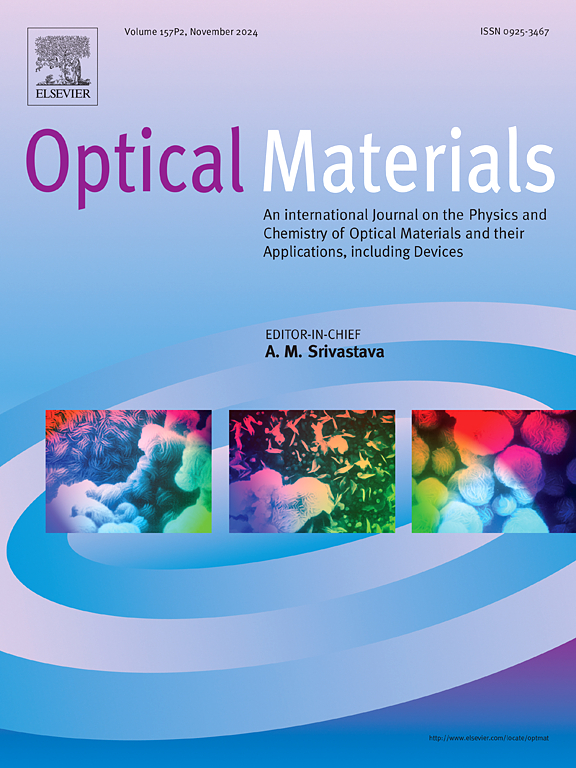Selective Fe3+ sensing probes with transport-Mimetic behaviour: DFT studies and molecular docking insights into transferrin receptor interactions
IF 3.8
3区 材料科学
Q2 MATERIALS SCIENCE, MULTIDISCIPLINARY
引用次数: 0
Abstract
In this study, we present the design, synthesis, and characterization of two coumarin-based fluorescent chemosensors, C1 (4-((4-((Benzo[d]oxazol-2-ylthio)methyl)1H-1,2,3-triazol-1-yl)methyl)-7-methoxy-2H-chromen-2-one) and C2 (4-((4-((Benzo[d]oxazol-2-ylthio)methyl)-1H-1,2,3-triazol-1-yl)methyl)-6-(tert-butyl)-2H-chromen-2-one), synthesized via click chemistry. The absorptive and emissive properties of probes were investigated with various metal ions, revealing an excellent luminescent sensing response to key micronutrients, specifically Fe3+ ions. Thermodynamic fluorescence studies demonstrated that the quenching of the probes by Fe3+ is dynamic, involving photo-induced electron transfer (PET) that reduces fluorescence intensity. The detection limit for Fe3+ was determined to be 1.88 μM for C1 and 2.06 μM for C2, indicating high sensitivity. Binding sites and interactions between the probes and metal ions were elucidated through density functional theory (DFT) calculations, supported by Fourier transmission infrared (FT-IR) and mass spectrometry. Additionally, molecular docking studies were performed with the human transferrin receptor, demonstrating strong binding affinities of −10.2 kcal/mol for C1 and -9.6 kcal/mol for C2 with key amino acid residues, suggesting their potential role as Fe3+ transporters, which may be useful in managing transferrin imbalances and related disorders. These findings highlight the potential of C1 and C2 as effective sensors for Fe3+ ions, with promising applications in biomedicine and molecular diagnostics.

具有运输模拟行为的选择性Fe3+传感探针:DFT研究和转铁蛋白受体相互作用的分子对接见解
在本研究中,我们设计、合成和表征了两种基于香豆素的荧光化学传感器,C1(4-((4-(苯并[d]恶唑-2-基硫)甲基)1h -1,2,3-三唑-1-基)甲基)-7-甲氧基- 2h - chromen2 -one)和C2(4-((4-(苯并[d]恶唑-2-基硫)甲基)- 1h -1,2,3-三唑-1-基)甲基)-6-(叔丁基)- 2h - chromen2 -one),通过点击化学合成。研究了探针对各种金属离子的吸收和发射特性,揭示了对关键微量元素,特别是Fe3+离子的优异发光传感响应。热力学荧光研究表明,探针被Fe3+猝灭是动态的,涉及光诱导电子转移(PET),降低了荧光强度。C1和C2的检出限分别为1.88 μM和2.06 μM,灵敏度较高。在傅里叶透射红外(FT-IR)和质谱分析的支持下,通过密度泛函理论(DFT)计算阐明了探针与金属离子的结合位点和相互作用。此外,与人类转铁蛋白受体进行的分子对接研究表明,C1和C2与关键氨基酸残基的结合亲和力为- 10.2 kcal/mol和-9.6 kcal/mol,表明它们可能是铁3+转运体,可能有助于管理转铁蛋白失衡和相关疾病。这些发现突出了C1和C2作为Fe3+离子有效传感器的潜力,在生物医学和分子诊断方面具有广阔的应用前景。
本文章由计算机程序翻译,如有差异,请以英文原文为准。
求助全文
约1分钟内获得全文
求助全文
来源期刊

Optical Materials
工程技术-材料科学:综合
CiteScore
6.60
自引率
12.80%
发文量
1265
审稿时长
38 days
期刊介绍:
Optical Materials has an open access mirror journal Optical Materials: X, sharing the same aims and scope, editorial team, submission system and rigorous peer review.
The purpose of Optical Materials is to provide a means of communication and technology transfer between researchers who are interested in materials for potential device applications. The journal publishes original papers and review articles on the design, synthesis, characterisation and applications of optical materials.
OPTICAL MATERIALS focuses on:
• Optical Properties of Material Systems;
• The Materials Aspects of Optical Phenomena;
• The Materials Aspects of Devices and Applications.
Authors can submit separate research elements describing their data to Data in Brief and methods to Methods X.
 求助内容:
求助内容: 应助结果提醒方式:
应助结果提醒方式:


